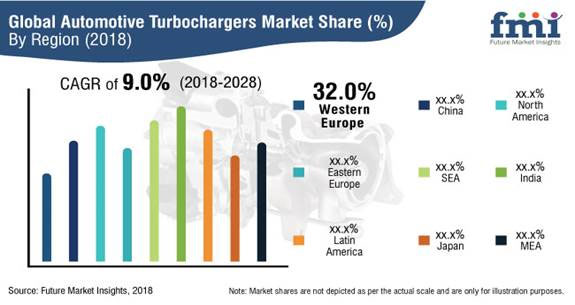Engine downsizing to optimise vehicle performance
Automotive turbochargers use the exhaust gases to drive a turbine, which leads to more fuel burning as the air compressor pushes extra oxygen or air into the cylinder. Automotive turbochargers help in achieving better fuel efficiency by increasing the pressure of the air coming in the engine.
Furthermore, the global market for Automotive Turbochargers is expected to witness significant growth in 2018. The market will reach a value of $9,589.9m while growing with a Y-o-Y growth rate of 6.6% as compared to 2017.
Furthermore, the global demand for Automotive Turbochargers will also be influenced by the implementation of stricter fuel economy standards and growing demand for engine downsizing for optimum vehicle performance.
Automotive turbochargers help in increasing the power output of engines by allowing more air per intake to the combustion chamber of powertrains. As compared to naturally charged atmospheric pressure engines, automotive turbochargers are a more efficient and eco-friendly technology as they offer increased engine power without increasing piston displacement.
Furthermore, automotive turbochargers producing companies are closely working with their customers through partnership programs focused on fuel economy, engine downsizing and emission control. This will further lead to significant advent of significant benefits, such as enhanced safety, lower prices, greener solutions and more comfortable drives.

Moreover, growing concerns regarding air quality and stringent emission standards for heavy-duty vehicles (trucks, buses, and coaches), light-duty vehicles (cars and vans) and other non-road mobile machinery will augment the growth of the automotive turbochargers during the forecast period.
The considerable increase in the application of automotive turbochargers in internal combustion engines and significant installation across diesel and high performance spark-ignition engines is also likely to propel the growth of the Automotive Turbochargers market over the forecast period.
In the recent past, the Automotive Turbochargers market has witnessed significant developments from the competition perspective. Product innovations through the inclusion of advanced manufacturing technology and building strong relationships with car manufacturers are some of the preferred strategies opted by prominent players to sustain their position in the global Automotive Turbochargers market.
Based on actuators, the electric segment is expected to remain dominant in terms of the global Automotive Turbochargers market volume share and will account for 70.6% share by the end of 2028.
Based on product type, the variable geometry technology segment is expected to remain the dominant segment in the global automotive turbochargers market and will account for more than 69.4% of the revenue by 2028 end.
On the other hand, twin turbo technology is estimated to witness substantial growth in the global automotive turbochargers market during the forecast period owing to growing energy extraction from four-cylinder profiles.
In 2017, Europe was the most attractive region in the global Automotive Turbochargers market and accounted for nearly 32.4% of the global market share. Further, being at the forefront in terms of Automotive Turbochargers production and consumption, the European region is pegged to control the global Automotive Turbochargers market in the future as well.





